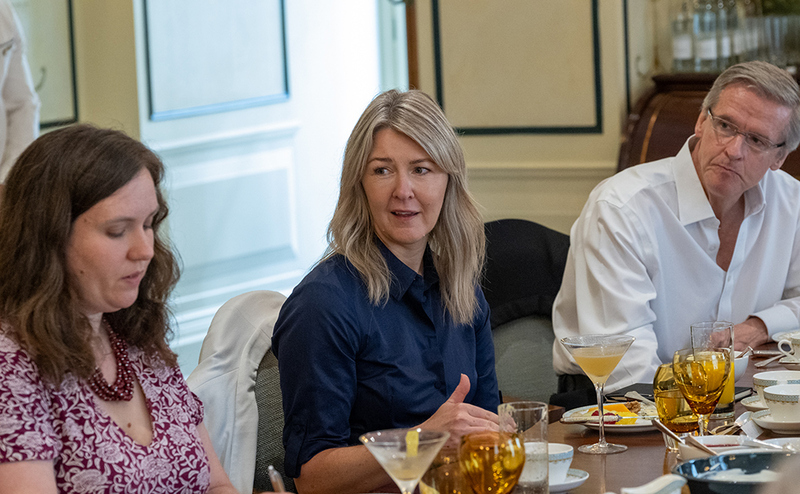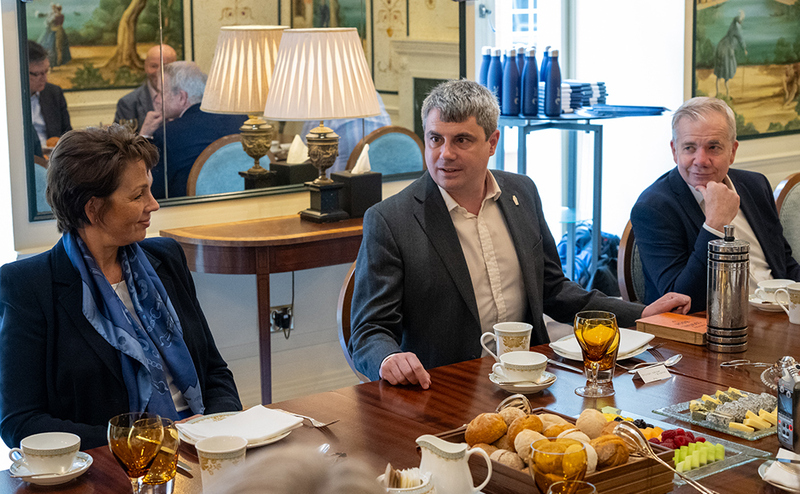
The panellists were (left to right): Vidett client director and head of trusteeship James Double; Pension Insurance Corporation senior origination actuary Louise Nash; PP editor Jonathan Stapleton; Tony Clark; Independent Governance Group trustee director Tim Giles; Law Debenture professional trustee Lynne Rawcliffe; Pension Insurance Corporation co-head of transition management Paul Barrett; Pension Insurance Corporation co-head of origination Tristan Walker-Buckton; Capital Cranfield professional trustee Richard Hubbard; Skanska UK head of pensions Mohsin Harhara; Burges Salmon partner Steven Hull; and Pan Trustees deputy chair Lynne Stewart-Brindle.
At the end of June, Professional Pensions assembled a panel of experts to discuss the current status of the buyout market for mid-sized schemes – those between £100m and £1bn in size – and ask if this segment of schemes is getting everything it needs or is in danger of becoming a ‘squeezed middle’ in the market.
The roundtable – chaired by PP editor Jonathan Stapleton and held in association with Pension Insurance Corporation – also exchanged views on whether these schemes are receiving the service they need and asked what the priorities are for the trustees of mid-sized schemes when it comes to bulk annuities and buyout.
Louise, could you introduce our topic for today please?
Louise Nash: We wanted to talk to you about mid-size schemes, by which we are talking about schemes from £100m to £1bn. The reason we picked this is that we felt we had had a lot of conversations over the last year around the small schemes of the market. We recently launched a small scheme offering, and there were a lot of conversations across the market with regards to what is the right solution for that end of the market. Equally, there is a lot of noise at the other end of the market about £1bn-plus schemes.
What is interesting is that when we look at the mid-size schemes, there are actually a similar number, if not slightly fewer, of those schemes in our pricing pipeline at the minute. This is very unusual because there are only around 230 schemes in the UK that are £1bn-plus, whereas there are 1,000 schemes or more in the mid-size bucket. It is an unusual feature of our current pipeline that we are seeing as much, if not more, activity from the very large schemes as we are from the schemes in the middle, which has traditionally been the beating heart of the buy-in and buyout industry.
In this roundtable, we really want to talk about what is going on for those schemes. What are the particular challenges and issues facing them relative to other schemes? We want to give them a bit of the attention that they deserve in terms of conversations in the market at the moment.
I have seen a couple of eye-catching stats in recent publications. The recent DLA Piper research on the small schemes market showed that while most, if not all, of the small scheme transactions (£100m or smaller) that come to market were completed, only around 70% of the £100m-£250m schemes that came to market went ahead to complete a deal, which suggests that something different is going on in that part of the market.
And there was also a report last year from Lane Clark & Peacock that noted the trend of a ‘squeezed middle' in which some of those schemes were not getting as many insurers quoting.
Our perspective is that these schemes are very attractive to pick as schemes to quote on – and we would be happy quoting on more of these schemes if they were coming to market.
There are some particular features and processes for those clients that it would be interesting to discuss, as well as talking about what the right strategy is for getting the best outcome from insurers. Potentially, there are also some specific issues for this segment of the market around illiquid assets and the resources needed to get these schemes to a successful outcome.
During this discussion, we are hoping to discuss some of these themes and talk about what is happening with this segment of the market.
Are mid-size schemes more likely to experience issues that prevent them from coming to market?
Richard Hubbard: Many medium-ish-sized schemes do struggle with the likes of GMP equalisation and the tidying up of data. Getting those sorts of things sorted can be so painful that it pushes back on the process of getting some of these schemes to market.
Paul Barrett: I think some of this is starting to change – we are beginning to see schemes complete GMP equalisation prior to transaction, which from a transition point of view to buyout, makes data cleansing and verification so much easier. But while we are in flux, we are still having to deal with a lot of the issues you have mentioned.
James Double: The resource issue is common across all schemes. It is not particularly a mid-size scheme issue, but there is a massive resource constraint. Going to market is a very time-intensive project, but mid-size schemes still have good options. As a firm, we have just taken a batch of mid-size schemes to market and we're expecting more insurer interest. With smaller schemes, you expect to go exclusive, whereas you expect competitive tension with mid-size schemes.
Lynne Rawcliffe: I wonder if the industry may have created some of the delays to schemes approaching the buy-in market? Some schemes may be hearing so much about how they should get themselves more ready in order to be attractive to insurers for a transaction – for example, by having their data clean – and how helpful it is to do GMP equalisation, that they may be thinking they should perhaps wait and get these things done first. Maybe they are delaying for that purpose.
Also, some schemes are deciding, actually, there is not such a big rush to buy in – some are deliberately thinking, ‘If we wait two to three years, my illiquids will have run off and I will not need to take a haircut on their value' and that it allows the membership to mature so that the cost of the buy-in can comes down a little bit as more members are pensioners instead of deferred ones.

Tim Giles: There are also schemes in this mid-sized bracket that want to think about run-on in more detail now. Some may have illiquid assets as part of their strategy and don't want to lose value. They are less likely to have insurers willing to find a workable solution to get around that. Medium-sized schemes are also more likely than smaller schemes to think there is an alternative to insurance and so are sitting in this, ‘do we do it or not?' scenario.
Mohsin Harhara: In terms of challenges, data is not one of them for us. We will be getting the data to a complete state that is ready for buyout in the near future. The bigger challenge is illiquids. Some 20% of our assets are illiquid. There are different types of illiquids as well. We have a mixture of property, private credit, private equity and real estate debt. It is a different challenge there. And there are different challenges for each type of illiquid.
We are aware that there are different things we can do to deal with the illiquids. The end result is going to be a jigsaw of different solutions, but we may not get away from having some haircut, which could be significant.
Is there capacity out there for schemes wanting to do deals?
Louise Nash: Yes, for all the noise that was made in the market towards the back half of last year, the first three months of this year were surprisingly quiet for schemes coming to market. But it is busy now – there are a lot of schemes in the market, but I do not see us turning away many schemes in this bracket.
Steven Hull: From an adviser perspective, it feels like there's an insurer year – broadly January-December – comprising few transactions in the first quarter, then getting progressively busier and then very busy towards the end of the final quarter. Whether it is driven by targets or by insurers having lost out earlier in the year coming back to the market with capacity to do a deal, there appears to be a lot more activity as the year continues.
Possibly, the first quarter is quiet because everybody is exhausted by the last half of the previous year, but it suggests for buyers a strategy of ‘let's get active in the first quarter, because we might find more competitive pricing' may prove successful.
Tristan Walker-Buckton: My very small hobby horse is that trustee meetings all happen at the same time and are driven by school holidays. We come back after Easter and all these requests for proposal (RFPs) land on the same day. Then there is a lot of pricing over the summer in order to deliver prices for September trustee meetings – those are the ones that are then executing in December.
Moving your trustee meetings back a couple of weeks, or forward a couple of weeks, and having them in the school holidays may have an impact.

Is capacity a concern when it comes to willingness to offer residual risks or deferred premium?
James Double: It would rule some insurers out if a trustee insisted they needed residual risk or deferred premiums to resolve the illiquid asset issues. We had a £70m scheme last year and needed a deferred premium due to illiquid assets. We ended up with one insurer that could accommodate this, so we had to go exclusive.
Louise Nash: With the level of market demand for deferred premium now, we have standardised our offering. With this, we are very open to any size of scheme, but it does come at a cost. There is always going to be an interest charge over the deferment period, so you do have to weigh up whether it is value for money or not.
Residual risk is a slightly different matter because of the sheer people power involved in pricing those transactions. For smaller schemes in this bracket, we would not consider residual risks, but for some of the larger deals, we are very happy to have a discussion if there is a very clear rationale for why that is something the trustees need.
How does a surplus position play into the consideration around buyout, and how is surplus being treated in the buyout process?
Steven Hull: Unless you have a truly gargantuan surplus, it doesn't change the strategic view of risk transfer. If there is a surplus at the end, that's nice, but the issue with surplus is it is governed by your trust deed and rules and (currently) a fairly stringent set of overriding legal requirements. The trust deed and rules are a complete "postcode lottery" as to who benefits from the surplus. Even when the employer benefits, it has to think about the reputational risk of taking the surplus out without sharing it with the members.
Lynne Stewart-Brindle: My job as a trustee is to pay the benefits in accordance with the rules. Most of those rules do not give trustees carte blanche to spend the money in any circumstance. Nine times out of ten, that surplus is heading back to the sponsor. The sponsor may give some pension increases if there have been lower pension increases in the past or pre-1997, but most of it ends up with the sponsor.
Richard Hubbard: As a trustee, though, I do argue that my members are losing something by buyout in terms of factors and control over it, particularly if there is a class of discretionary beneficiary who might be excluded. They are losing out; therefore, some modest augmentation is appropriate.
What can make schemes more or less attractive in terms of pricing? How difficult is it to get reinsurance in this segment?
Louise Nash: We see it being as competitive in the mid-size end of the market as at the high end. We have had pretty varied experiences around the number of insurers bidding – and it can range from two or three to six or seven. Six or seven insurers bidding is always going to result in a very strong competitive process. When there are two or three, it is sometimes because there are complications in the scheme.
This is also a lovely size, from an asset strategy side, to insure. You are getting a lot of benefit from the good assets, and they are not being averaged out by a big portfolio for a bigger scheme. Theoretically, you should get a good price for these schemes.
The theme in reinsurance is that this is the most challenging area for us to get live reinsurance pricing to back the prices that we are putting forward. But it is not a material problem, so we are still doing deals at this level. We are very experienced with what reinsurance pricing we are likely to eventually get, so we are willing to put forward a price assuming what pricing we will achieve in the long run. There are always going to be winners and losers for us in terms of the individual deals. It will never be known to the scheme, but behind the scenes, it will average out for us. Individual schemes might do better or worse from that averaging.
Saying that, the market needs to solve the issue of how we can get real reinsurance pricing for these mid-size schemes that fairly reflects the demographics of that scheme. There is a lot to be done on the standardisation of data and the quality of the experience data, which would make that process easier.
Tristan Walker-Buckton: I am sometimes surprised at the number of quotes. For example, there can be a £500m scheme that has a good RFP (request for proposal), no issues with data, is using a good employee benefit consultancy (EBC) and is definitely into surplus. This scheme could have two or three insurers quoting on it, whereas another could have six or seven and I just have no idea why. Maybe it is due to timing.
On the reinsurance point, I would add that reinsurers will often want to get through the first round of pricing and have a bit more transaction certainty. We assume that we will have a good idea as to where the reinsurance will come out at, but we are still guessing. As an insurer, we do not want to go in too aggressively and have to walk our price back.
I have also had the odd situation where I have gone in and presented a price. At round two, I have more reinsurance quotes in and, suddenly, my price has reduced by quite a lot. That is the kind of challenge that we try to manage.
We have spoken about what happens after the initial process but the journey afterwards is just as important, if not more so. Paul, can you talk about that transition and what comes afterwards?
Paul Barrett: Typically, the starting position is to undertake cleansing of the data then come back to us and agree this within 18 months or two years; this tends to be a number of iterations of data, which is a challenge. It boils down to planning, governance, data quality and, in particular, the quality of the data. This includes the nemesis of GMP equalisation as well.
From our perspective, we engage very early. As soon as we sign, we talk to all the advisers and administrators to understand the cleansing that they are going to do. Sometimes that does not align with what has been agreed in the contract, so there would more realignment to make sure that the work that is going to be done is fit for purpose.
Third-party administration capacity is an issue. With a number of third-party administrators (TPAs), for instance, there is a business as usual, admin team, a de-risking data team, a GMP equalisation team, and an external consultant advising on GMP equalisation. There are four parties effectively trying to deliver one product. From our perspective, that certainly has become an issue. We think this kind of problem will tail off, because schemes are generally starting to get ready before the transaction. It is really about how we manage that process within the contractual timescales, and we do help by providing guidance and training where we can.
On the back of that, we can agree the data and say, ‘You owe us £1m' or ‘We owe you £1m' – and it is quite a journey to get there. And then we need to move the administration to us, which typically takes six months from agreeing the data.
It has become more of a conveyor belt than it used to be. It used to be peaks and troughs, whereas now it is a steady two or three schemes a month. Transitioning two to three schemes a month to our admin model is time and labour intensive.
Having good, strong trustees helps immensely. We also need to manage other parties that we do not have a contractual relationship with. The ones where we have a strong relationship with end with better results and are more efficient.
There are a lot of moving parts there, but it is normally a two-to-three-year journey. The more we can get out of that position and the more we get clean data to price on at the very beginning, the shorter the data cleanse becomes and the more quickly we can help trustees get to buyout.
What are your key takeaways or concluding comments from this discussion?
Tim Giles: It comes back to where we started in terms of the barriers in the mid-market. Issues with illiquid assets or making a choice whether to run-on or not are likely to affect this part of the market more. There are other things, however – and there are definitely resourcing challenges around administration that come through as well, but this is less specific to the mid-market.
Tony Clark: Things take far too long. Things need to be quicker, with less admin and more accuracy.
Mohsin Harhara: Removing risk from the books is a major priority for many firms. As such, the priorities need to be getting the data and GMP equalisation sorted out. We need to get the data in the best possible state so that we can get the best pricing and a smooth process. Dealing with the illiquids is another conundrum that many schemes need to tackle.
Richard Hubbard: At the beginning of the year, I thought it would be really difficult to get engagement with insurers – there was so much talk about the amount of business coming their way. In practice, I found it relatively easy to get multiple quotes on small, medium and large schemes, so that has been a much better experience than I feared. Saying that, I do sometimes get frustrated at how slowly we do things in the pensions world.

Lynne Rawcliffe: I would echo a couple of thoughts. Some schemes are deliberately deferring transactions for various reasons and circumstances. For those that want to transact now, it does seem like there is enough interest and capacity in the market. Lastly, I would like to mention the point about member options. Another reason why schemes may be deferring a transaction, if feasible, is so that they can continue to give their deferred members more flexibility with retirement benefit options (such as bridging pensions and pension increase exchanges), given that many insurers are currently unable or unwilling to offer the same flexibility, or only at a significant cost.
Steven Hull: From an adviser perspective, it is very encouraging to hear of insurer capacity within the market and an ability and willingness to transact with schemes in the mid-sized space.
Ultimately, schemes are in a myriad different positions, but it is good to hear there is capacity and a willingness to transact on competitive terms.
James Double: All schemes are different. There will be a different nuance in every scheme, especially in this mid-range size. But you should not be going to the insurer to get quotes if there is a big unknown there – you need to have done sufficient due diligence to resolve or at least understand the size of any legal or data issues before going to market. You also need expertise on the trustee board and you need the right advisers working with you to solve any problems there might be.
Saying this, there are so many solutions out there… There are solutions for all the challenges I have seen leading up to securing buy-ins, and you should be able to find one for your problem. Be prepared and then take it to market. If you have set out the due diligence and any issues uncovered to the insurers, you will get a competitive tender for mid-sized schemes.
Lynne Stewart-Brindle: Just looking at that middle market, the reason why they have paused may be the illiquids, the GMP equalisation or the other bits and pieces. I think they are pausing because something changed. Something made them better funded and brought them closer to the deal, so they have to think carefully about it.
Saying that, I think that in the next 24 months there is going to be a barrage of mid-sized schemes queuing at the door and wanting quotations. They will realise, ‘What are we talking about? We wanted rid of it before and we want rid of it now, so that seems the right thing to do'. They calculate that payback period as to all the operational costs that they are going to save. It is a simple calculation. They will say: ‘We are ready. Let us go, and then we can get on and run our business, which is not pensions.'
Paul Barrett: Unsurprisingly, for me it is about how we speed things up post transaction. Standardised data would be music to my ears. As GMP equalisation matures and is completed more efficiently, projects will complete more quickly. The other thing is that many of the challenges faced by schemes in this area are across the piece and not just dependent on the size of the scheme. It is about the complexity, the changes to lead times and the history behind the schemes.
This roundtable was held on 27 June 2024 in association with Pensions Insurance Corporation (PIC)






